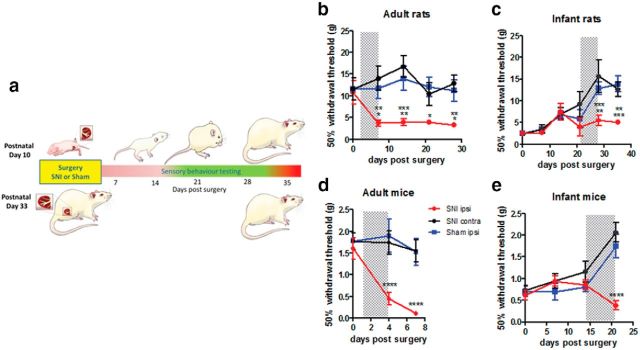Figure 1.
Nerve injury in infant rats and mice produces a delayed-onset adolescent mechanical pain hypersensitivity. a, SNI was performed in infant and adult rats and mice, and hindpaw mechanical withdrawal thresholds were tested with vFhs on the ipsilateral paw (SNI ipsi) up to 35 d postsurgery. Results were compared with data from the contralateral paw (SNI contra) and sham surgery (sham ipsi). b, SNI causes a rapid decrease in ipsilateral mechanical thresholds in adult rats (two-way ANOVA, F(2,15) = 9.616, p = 0.002, SNI surgery: n = 6, sham surgery: n = 6, i.e., n = 6 per group) and (d) adult mice within 7 d postsurgery (two-way ANOVA, F(2,12) = 23.28, p < 0.0001, n = 5 per group). In contrast, infant SNI has no early effect on mechanical withdrawal thresholds, which increase, as normal, with postnatal age. Thresholds do not fall until 28 d postsurgery in (c) rats (two-way ANOVA, F(2,19) = 8.487, p = 0.0023, n = 7 per group) and 21 d postsurgery in (e) mice (two-way ANOVA, F(2,16) = 8.872, p < 0.0026, n = 6 per group). Shaded areas highlight the time period when hypersensitivity develops in each group. Graphs are presented as mean ± SEM (two-way ANOVA, Bonferroni's post hoc test; *p < 0.05, **p < 0.01, ***p < 0.001,****p < 0.0001).

